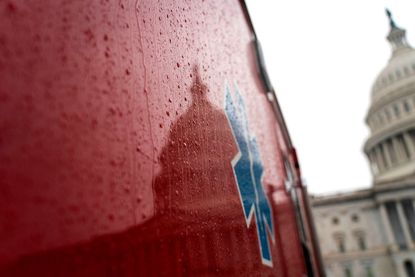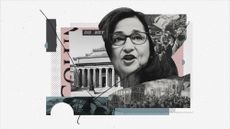Here's how the U.S. government plans to spend $2.2 trillion to save the economy from coronavirus


Senate and White House negotiators threw together the largest economic rescue bill in modern U.S. history in less than a week, and the final version of the $2.2 trillion package — passed unanimously in the Senate late Wednesday — has a lot of money for a lot of businesses and institutions. The goal of the legislation is to shore up the U.S. economy and civil society during the COVID-19 coronavirus pandemic. Here's where some of that money will go:
Direct cash payments: Most Americans will get checks of up to $1,200 plus $500 per child, at a cost of about $290 billion.
Hospitals: $100 billion is for grants to hospitals and health care providers struggling to purchase critical supplies and losing money from postponed elective surgeries. There's also money for community health centers, Medicare, telehealth, and public health agencies.
Subscribe to The Week
Escape your echo chamber. Get the facts behind the news, plus analysis from multiple perspectives.

Sign up for The Week's Free Newsletters
From our morning news briefing to a weekly Good News Newsletter, get the best of The Week delivered directly to your inbox.
From our morning news briefing to a weekly Good News Newsletter, get the best of The Week delivered directly to your inbox.
Unemployment: The bill sets aside $260 billion to expand unemployment payments to a broader group of workers affected by the pandemic, add 13 weeks of coverage for the unemployed, and boost weekly payments by up to $600.
State and local governments: $150 billion will go to help state and local governments weather the outbreak, including a minimum of $1.5 billion per state and $8 billion for tribal governments. There's another $25 billion in state infrastructure grants.
Small businesses: $377 billion is set aside for zero-interest loans and other payments for businesses with fewer than 500 employees — including nonprofits and individual hotels and restaurants from large chains. The loans will be forgiven if the companies retain their employees and meet other conditions.
Big businesses: The bill has $500 billion for industries hit especially hard by the pandemic. This includes $50 billion for passenger airlines — $25 billion in loans, $25 billion in grants — $8 billion for cargo carriers, and $17 billion for "businesses critical to maintaining national security" (read: Boeing). The other $425 billion is loans allocated through Federal Reserve programs, with some limits on executive compensation and stock buybacks, new oversight mechanisms, and a ban on participation by companies significantly controlled by President Trump, other top administration officials, members of Congress, or their families.
Miscellaneous: The Pentagon receives $10.4 billion, FEMA gets $45 billion, $25 billion goes for food stamps, $25 billion for public transit systems, $31 billion for local schools and colleges, and states get $400 million to prepare for the 2020 elections, including expanding vote-by-mail and polling locations.
Find more details at Politico, The Associated Press, and The Washington Post, and learn more about the fine print at The New York Times.
Create an account with the same email registered to your subscription to unlock access.
Sign up for Today's Best Articles in your inbox
A free daily email with the biggest news stories of the day – and the best features from TheWeek.com
Peter has worked as a news and culture writer and editor at The Week since the site's launch in 2008. He covers politics, world affairs, religion and cultural currents. His journalism career began as a copy editor at a financial newswire and has included editorial positions at The New York Times Magazine, Facts on File, and Oregon State University.
-
 Is the Gaza war tearing U.S. campuses apart?
Is the Gaza war tearing U.S. campuses apart?Today's Big Question Protests at Columbia University, other institutions, pit free speech against student safety
By Joel Mathis, The Week US Published
-
 DOJ settles with Nassar victims for $138M
DOJ settles with Nassar victims for $138MSpeed Read The settlement includes 139 sexual abuse victims of the former USA Gymnastics doctor
By Justin Klawans, The Week US Published
-
 14 recent scientific breakthroughs
14 recent scientific breakthroughsIn Depth From photos of the infant universe to an energy advancement that could save the planet
By Devika Rao, The Week US Published
-
 Empty-nest boomers aren't selling their big homes
Empty-nest boomers aren't selling their big homesSpeed Read Most Americans 60 and older do not intend to move, according to a recent survey
By Peter Weber, The Week US Published
-
 Brazil accuses Musk of 'disinformation campaign'
Brazil accuses Musk of 'disinformation campaign'Speed Read A Brazilian Supreme Court judge has opened an inquiry into Elon Musk and X
By Rafi Schwartz, The Week US Published
-
 Disney board fends off Peltz infiltration bid
Disney board fends off Peltz infiltration bidSpeed Read Disney CEO Bob Iger has defeated activist investor Nelson Peltz in a contentious proxy battle
By Rafi Schwartz, The Week US Published
-
 Disney and DeSantis reach detente
Disney and DeSantis reach detenteSpeed Read The Florida governor and Disney settle a yearslong litigation over control of the tourism district
By Peter Weber, The Week US Published
-
 Visa and Mastercard agree to lower swipe fees
Visa and Mastercard agree to lower swipe feesSpeed Read The companies will cap the fees they charge businesses when customers use their credit cards
By Peter Weber, The Week US Published
-
 Reddit IPO values social media site at $6.4 billion
Reddit IPO values social media site at $6.4 billionSpeed Read The company makes its public debut on the New York Stock Exchange
By Peter Weber, The Week US Published
-
 Housing costs: the root of US economic malaise?
Housing costs: the root of US economic malaise?speed read Many voters are troubled by the housing affordability crisis
By Peter Weber, The Week US Published
-
 Feds cap credit card late fees at $8
Feds cap credit card late fees at $8speed read The Consumer Financial Protection Bureau finalized a rule to save households an estimated $10 billion a year
By Peter Weber, The Week US Published